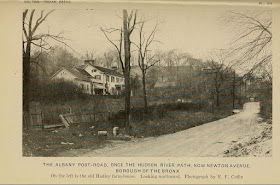Native Americans watch as Sir Henry Hudson arrives in New
York in 1609, by Edward Moran in 1898.
This sounded great:
MAP: See What Manhattan Looked Like in 1609
By Savannah Cox | September 29, 2015
"Utilizing satellite and historical maps, GPS and mounds of
data, the Welikia Project — which was formerly called the Mannahatta Project and is spearheaded by Wildlife
Conservation Society ecologist Eric Sanderson — painstakingly recreates
Manhattan's 17th century ecology, and offers its findings in one incredibly
detailed and interactive map: https://welikia.org/m-map.php
In addition to supplying users with information on 17th
century Manhattan's natural features, when a site visitor selects a block,
Welikia provides figures on the space's likely historical use by the Lenape,
the people who lived in Manhattan before Europeans arrived.
It is actually from this indigenous population that Welikia
gets its name, which in Lenape means "my good home."
So I clicked on the interactive map link:
And yesterday it worked just fine, little sections outlined and details in a box,
a tab even for land use by the Lenape:
But, as my friend, Dr. Johnnie Rock Lobster, who had sent the link to me noted: "Where are the villages, trails, cleared forests, etc. of the Manhattan people who inhabited and modified the island or is the map simply another expression of the "pristine (wilderness)?"
And, later on I thought to myself: "Also too, are they missing any possible "stone walls" that might have been there before the Dutch arrived?"
I had to admit I momentarily missed all that, fell into the Cultural Trap, even though the last time I drove into the City I saw all those undulating Serpent-like stone walls, all the way down into the suburbs of Westchester County. Another link to a similar story read: "It’s hard to imagine New York as anything but a dense
landscape of glassy towers, apartment buildings and millions of bodies moving
throughout the streets. But once upon a time, the city wasn’t much more than
forests, creeks and wildlife."
Well of course it wasn't like that in 1609, the year Henry Hudson was so surprised to find that
a large tidal estuary and so much more was named after him. Maybe some of the forests had grown back after all the rats had jumped ship, carrying European fleas full of diseases, maybe villages were abandoned as pigs rooted up clam gardens and maize, squash and bean fields, sneezing out clouds of Swine Flu pathogens, spreading like wildfire and drastically diminishing the controlled fires, enough to disrupt the global the climate, cause a Little Ice Age.
So maybe someone should create a circa 1491 interactive map, one that includes the little bits of information found in "Indian Paths of the Great Metropolis" by Reginald Pelham Bolton, combine it with some of the still existing Indigenous Stonework from other places (like around my neighborhood or maybe my Mom's on the shoreline better still). ..
Maybe show a cornfield like this one, "the fenced in place," circled in red:
I suspect there was more than just one clearing for a cornfield:
Might there have been some blueberry fields or groves of wild plums,
kept in production by controlled burns - cranberry bogs maintained by managed streams.
I don't doubt that stone walls bounded trail or two, also kept clear by fire:
Where's the "Bowlder Fences" - or at least one or two?"
Where are the Burial Grounds, maybe the Mounds over them, before they were plowed down again and again?
How many years worth of shell heaps would there be?
Did you notice how many are shown in the maps, described in the text?
Rock Shelters, Forts alluded to...
Where are the weirs?
The drying fields and racks and smoke from the fires?
Browse into the appendix of Stations (does this mean "Archaeological Sites" in the Language of 1922?) on the Maps, and the list of things that could be on that map that resembles a mythical Pristine Wilderness, "not much more than forests, creeks and wildlife."
Bolton's Book: https://archive.org/details/indianpathsingre00bolt
























No comments:
Post a Comment